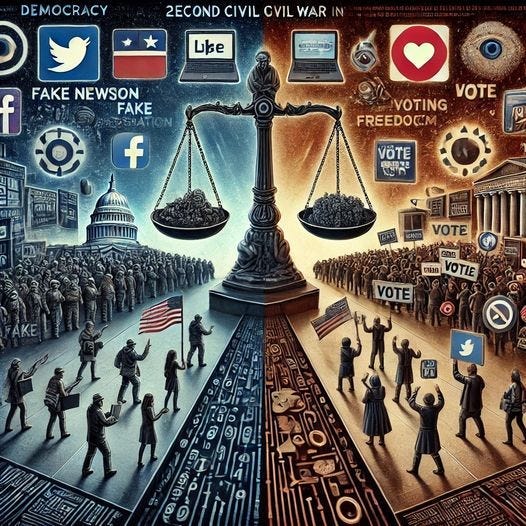Civil War II
Proving That We Are in a 2nd Civil War
The notion that we are in a second civil war, albeit in an information age rather than a traditional battlefield, can be substantiated through several key points.
These points highlight the intense ideological division, widespread misinformation, and systemic conflicts that mirror the conditions of the first civil war, albeit through modern mechanisms.
1. Ideological Polarization
Evidence:
Political Division: The United States is experiencing unprecedented levels of political polarization. Surveys and studies, such as those conducted by the Pew Research Center, show that Americans are more divided along ideological lines than at any point in recent history.
Geographic Segregation: Similar to the North-South divide of the first civil war, there is a significant geographic component to this polarization. States and even regions within states show stark contrasts in political leanings and values.
Implication:
The ideological rift is deepening, with both sides viewing each other not merely as political opponents but as existential threats to their way of life and values.
2. Misinformation and Propaganda
Evidence:
Social Media Influence: Platforms like Facebook, Twitter, and YouTube have become battlegrounds for misinformation and propaganda. Studies have shown that false news spreads faster and more widely than factual news, contributing to polarized views and radicalization.
Targeted Disinformation Campaigns: There is substantial evidence of both domestic and foreign actors engaging in disinformation campaigns to sow discord and manipulate public opinion. For example, the U.S. intelligence community has reported on efforts by foreign governments to influence elections and public sentiment.
Implication:
The weaponization of information creates an environment where truth becomes relative, and trust in traditional institutions erodes, further entrenching divisions.
3. Cultural and Social Conflicts
Evidence:
Protests and Counter-Protests: The frequency and intensity of protests, such as those seen in response to racial injustice (e.g., Black Lives Matter) and political events (e.g., the January 6 Capitol insurrection), indicate a society in deep conflict.
Legislative Battles: Fierce legislative battles over issues like voting rights, gun control, and reproductive rights reflect the broader cultural war between progressive and conservative values.
Implication:
These cultural and social conflicts are not merely political disagreements but are deeply rooted in differing worldviews and values, mirroring the sectional conflicts that led to the first civil war.
4. Economic Inequality and Disparities
Evidence:
Economic Divide: There is a significant economic divide between regions, often aligning with political affiliations. For example, many of the states pushing for Project 2025 and supporting authoritarian-leaning policies have higher rates of poverty and receive more federal aid compared to their contributions.
Impact of Globalization: The impact of globalization has not been uniform, with certain regions and demographics feeling left behind, fueling populist and nationalist sentiments.
Implication:
Economic disparities contribute to social unrest and provide fertile ground for extremist ideologies, similar to the economic factors that played a role in the first civil war.
5. Attacks on Democratic Institutions
Evidence:
Erosion of Trust: Trust in democratic institutions, such as the electoral system and the judiciary, is eroding. Efforts to undermine the results of democratic elections, as seen in the widespread acceptance of unfounded claims of electoral fraud in the 2020 Presidential election, threaten the very foundation of democracy.
Authoritarian Tendencies: The rise of authoritarian rhetoric and policies, particularly from figures associated with the MAGA movement, mirrors the anti-democratic tendencies that led to the secessionist movement in the 1860s.
Implication:
The undermining of democratic institutions and the normalization of authoritarian rhetoric indicate a profound crisis in governance and democracy, akin to the conditions preceding the first civil war.
Conclusion
While we are not witnessing a civil war with traditional battlefields and armies, the ideological, informational, cultural, economic, and institutional conflicts present today bear significant resemblance to the divisions that led to the first civil war. The combination of these factors constitutes a modern-day civil war fought through information, influence, and institutional control. Recognizing this reality is crucial for developing strategies to address and heal these deep-seated divisions, ensuring a more united and democratic future for America.


